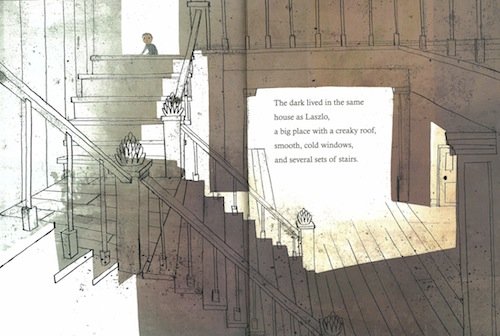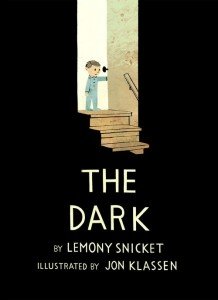Geez, it seems like I just finished writing about Jon Klassen’s This is Not My Hat and another book has appeared on the shelves. The guy is a machine, and I mean this in the nicest way possible. Just because he is prolific doesn’t mean his work is less than magnificent each time out. On the contrary, Klassen continues to show us unique facets of his creativity, which is boundless, if not a little warped. With The Dark, Klassen teams with fellow quirkmeister of children’s literature, Lemony Snicket for a singular unfortunate event, rather than a series. The monochromatic story is set in an old house, with a claw-foot tub and a lot of creaky wooden doors. Young pajama-wearing Laszlo is afraid of the dark, which is an actual thing in residence alongside Laszlo and his family. The dark hides in closets, behind shower curtains, or ‘pressed up against some old, damp boxes’, but mostly spends its time in the basement.
 Snicket and Klassen anthropomorphize darkness into a sort of physical presence, a not uncommon projection of a for an imaginative child. Something to be feared, yes, but also talked to and negotiated with. Each morning, Laszlo gamely greets the dark at the top of the stairs, hoping to prevent further visitations in his room. I confess I was afraid of the dark when I was a child. I was the youngest in my family, and therefore first to bed. I would freeze in place under the covers, afraid to move, until hours later when I heard the first footstep up the stairs, rescuing me from whatever lurked in the dark corners of my room. It did not matter who the person was on the staircase; another human being on the second floor meant I was safe. The dark did not like multiples. This lasted a few years. Once I discovered Junior High and Stephen King, the dark seemed the least of my worries.
Snicket and Klassen anthropomorphize darkness into a sort of physical presence, a not uncommon projection of a for an imaginative child. Something to be feared, yes, but also talked to and negotiated with. Each morning, Laszlo gamely greets the dark at the top of the stairs, hoping to prevent further visitations in his room. I confess I was afraid of the dark when I was a child. I was the youngest in my family, and therefore first to bed. I would freeze in place under the covers, afraid to move, until hours later when I heard the first footstep up the stairs, rescuing me from whatever lurked in the dark corners of my room. It did not matter who the person was on the staircase; another human being on the second floor meant I was safe. The dark did not like multiples. This lasted a few years. Once I discovered Junior High and Stephen King, the dark seemed the least of my worries.
“I want to show you something,”
As befits a story penned by Mr L. Snicket, Laszlo’s attempt to placate the dark fails, his nightlight goes out, and the dark envelopes his room. “I want to show you something,” says the dark. A resigned but brave Laszlo grabs his flashlight and wanders room to room, with the dark leading the boy to the basement, the one place he had never dared to come at night, and directs him to a chest of drawers. What he finds in the bottom drawer resolves the story in a funny and satisfying way. As the saying goes, better to light a candle than curse the dark, or in Laszlo’s case, fear it.
A recurring stylistic theme in Klassen’s most recent books is the play of light and dark, mostly dark. Indeed, a book  about the dark was almost inevitable. Klassen creates vivid gouache and digital illustrations within a limited palette. A striking use of line and speckled earth tones are illuminated by the shafts of light thrown by Laszlo’s flashlight. On an otherwise black page, these bold blocks of colour are exciting moments of revelation, and also relief, as they banish the dark to the corners of the page. The Dark is a perfect match of word and imagery. Snicket and Klassen slowly build tension with exquisite restraint. There are no real monsters here, but an undercurrent of tension and a teasing sort of menace.
about the dark was almost inevitable. Klassen creates vivid gouache and digital illustrations within a limited palette. A striking use of line and speckled earth tones are illuminated by the shafts of light thrown by Laszlo’s flashlight. On an otherwise black page, these bold blocks of colour are exciting moments of revelation, and also relief, as they banish the dark to the corners of the page. The Dark is a perfect match of word and imagery. Snicket and Klassen slowly build tension with exquisite restraint. There are no real monsters here, but an undercurrent of tension and a teasing sort of menace.
In previous reviews, I have commented on the vintage look of Klassen’s illustrations. The art seems of another era, while the humour is wonderfully sly and contemporary. In The Dark, the drawings, especially of inanimate objects like the staircase, have much in common with 60’s advertising art, and the slightly exaggerated, imperfect outlines and skewed angles found in the backgrounds of Warner Brother’s cartoons, specifically Bugs Bunny. More than this, both Snicket and Klassen share a Bugs Bunnyesque sense of mischief.
 I have a small quibble with the book. There is a page of text near the end that reads like a concluding statement directed at the reader. It would be fine at the actual end of the book, not several pages before. The page is conspicuously out of place, interrupting the narrative and breaking the tension of the story just as Laszlo is about to discover what the dark wants from him. I had a look online to see if it was a printing error, but no mentions on the interwebs. I am curious to find out if it was intentional.
I have a small quibble with the book. There is a page of text near the end that reads like a concluding statement directed at the reader. It would be fine at the actual end of the book, not several pages before. The page is conspicuously out of place, interrupting the narrative and breaking the tension of the story just as Laszlo is about to discover what the dark wants from him. I had a look online to see if it was a printing error, but no mentions on the interwebs. I am curious to find out if it was intentional.
On a Canadian note, The Dark by Lemony Snicket is not to be confused with The Dark by Robert Munsch. In the Munsch story, a dark pops out of an otherwise empty cookie jar and begins consuming all the shadows in the house and in the neighbourhood. Fun story, and interestingly, it also personifies dark as a kind of presence. Unlike Snicket’s The Dark, however, the humour is much more frenetic, and the illustrations fall into the serviceable category.
Lemony Snicket is a pseudonym for Daniel Handler, the author of A Series of Unfortunate Events, and many other unfortunate things for kids. I made a point of lining my nieces bookshelves with the Snicket oeuvre when they were younger, like I now line my own with Klassen. To this day, my niece has a serious fondness for pinstripe suits.
On the flyleaf of The Dark it states that Jon Klassen was born in Winnipeg, where the dark arrives ‘early for much of the year.’ As someone who lives in a city even farther north than Winnipeg, I can attest that darkness is ever-present during the winter months. Whether it served as inspiration for The Dark, or Klassen’s eventual move to California, is a question only he can illuminate. What is known is his brilliance. Jon Klassen is the 2012 winner of the Caldecott Medal for Illustration for This is Not My Hat, and received Canada’s highest honour, the Governor General’s Award for Cats’ Night Out in 2009.
 The Dark by Lemony Snicket, illustrations by Jon Klassen (Harper Collins, 2013)
The Dark by Lemony Snicket, illustrations by Jon Klassen (Harper Collins, 2013)
Jon Klassen has graced this blog many times before. Here’s proof:


Love the artwork. Both classic and innovative.